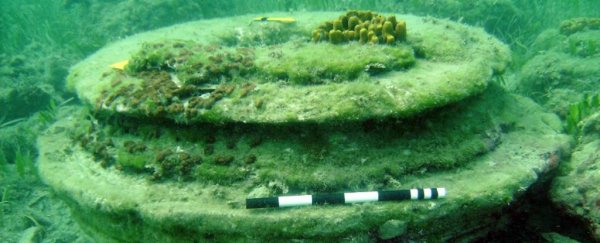When divers off the coast of Greece's Zakynthos Island came across what looked like paved floors and courtyards on the bottom of the sea back in 2013, they thought they'd just stumbled on a long lost city that was likely swept away by an ancient tidal wave.
Now, after fully studying the area, researchers have determined that the odd structures are not the remnants of a lost city (sorry, archaeologists) but are actually the result of a natural geological phenomenon that took place roughly 5 million years ago, during the Pliocene era.
Yup, according to a new study conducted by a joint team of researchers from the University of East Anglia in the UK and the University of Athens in Greece, the formations, which at first glance looked a lot like the bases of marble columns and other structures, actually formed when bacteria started to feast on methane gas as it leaked through the seafloor.
Which, when you think about it, is possibly even cooler than ancient ruins.
Over time, this bacteria caused a chain reaction that led to the cementation of sediment in the form of doughnut-like discs. These discs seem out of place in nature because they do not fit into their surroundings, especially on the ocean floor, which often appear much less uniform.
 UEA
UEA
"It's not particularly common, but it's not something we haven't seen or experienced before," team leader Julian Andrews, from the University of East Anglia, told Gabriel Samuels from The Independent. "It is however quite rare to find something like this in shallow waters."
"This kind of thing tends to happen where you get significant amounts of methane seeping from oil reservoirs beneath the seabed, similar to a site I worked on in Scotland back in the 1980s," Andrews continued.
The site was originally studied by the Ephorate of Underwater Antiquities of Greece - a government-run organisation that oversees many underwater archaeological digs in and around Greece. They ran preliminary mineralogical analyses, but weren't able to determine how the structures came about.
This led to the formation of the current study's team, which continued to analyse the mineral composition using microscopy, X-ray, and stable isotope techniques, allowing them to eventually come to their conclusion.
"We investigated the site, which is between 2 and 5 metres under water, and found that it is actually a natural geologically occurring phenomenon," Andrews said in a statement.
 UEA
UEA
This isn't the first time a naturally occurring geological phenomena have appeared to be human made. For years, people were confused by Turkey's 'fairy chimneys', which look like a series of crafted monuments that stretch across Anatolia.
Unfortunately for many believers, these formations were not the work of fairies (or humans), but actually formed thanks to volcanic eruptions millions of years ago that dumped ash and debris all over the region, eventually withering away to the odd monument-like structures that still stand there today.
So, while it's a bit disappointing for those of us who love a good lost city story, the results are proof that we're getting better and better at discerning what is natural and what is human-made, which will definitely come in handy when we eventually find Atlantis (fingers crossed).
Plus, being able to look at the work of hungry methane-eating bacteria 5 million years ago and see it for what it is is pretty damn awesome.
The team's results were published in the Marine and Petroleum Geology.
